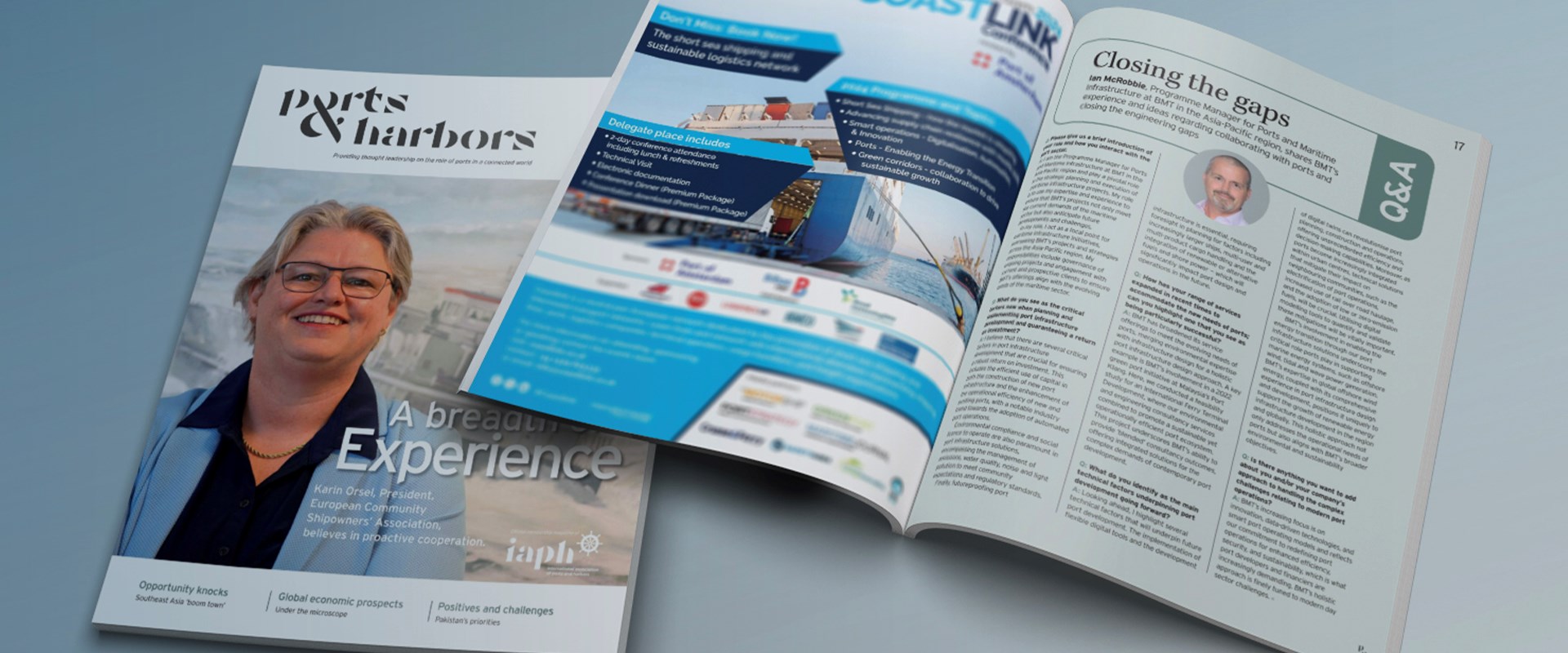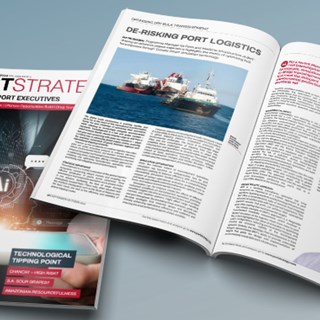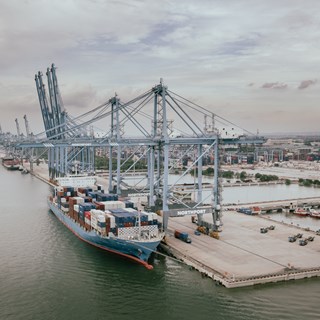
Closing engineering gaps: our journey in collaborating with ports
Ian McRobbie, our Programme Manager for Ports and Maritime Infrastructure, shares experiences and ideas regarding collaborating with ports and closing the engineering gaps
19 March 2024
This article was first published in the March – April 2024 issue of Ports & Harbors, the official magazine of the International Association of Ports & Harbors (IAPH). It is reproduced here by kind permission of IAPH
I am the Programme Manager for Ports and Maritime Infrastructure at BMT in the Asia-Pacific region, playing a pivotal role in the strategic planning and execution of maritime infrastructure projects. My role is to use my expertise and experience to ensure that BMT’s projects not only meet the current demands of the maritime sector but also anticipate future developments and challenges. In my role, I act as a focal point for maritime infrastructure initiatives, overseeing BMT’s projects and strategies across the Asia-Pacific region. My responsibilities include governance of ongoing projects and engagement with current and prospective clients to ensure BMT’s offerings align with the evolving needs of the maritime sector.
I believe that there are several critical factors in port infrastructure development that are crucial for ensuring a robust return on investment. These include: the efficient use of capital, both in the construction of new port infrastructure and, enhancing the operational efficiency of both new and existing ports, with a notable industry trend towards the adoption of automated port operations.
Environmental compliance and social license to operate are also paramount in port infrastructure solutions, encompassing the management of emissions, water quality, noise, and light pollution to meet community expectations and regulatory standards.
Finally, future-proofing port infrastructure is essential, requiring foresight in planning for factors including increasingly larger ships, multi-user and multi product cargo handling and the integration of renewable or alternative fuels and shore power; which will significantly impact port design and operations in the future.
BMT has broadened its service offerings to meet the evolving needs of ports, merging environmental expertise with infrastructure design for a holistic port infrastructure design approach. A key example is BMT’s involvement in a 2022 green port initiative at Malaysia’s Port Klang. Here, we conducted a feasibility study for an International Ferry Terminal Development, where our environmental and engineering consultancy services combined to promote a sustainable yet operationally efficient port ecosystem. This project underscores BMT’s ability to provide ‘blended’ consultancy outcomes, offering integrated solutions for the complex demands of contemporary port development.
Looking ahead, I highlight several technical factors that will underpin future port development.
The implementation of flexible digital tools and the development of digital twins can revolutionise port planning, construction, and operations, offering unprecedented efficiency and decision-making capabilities. Moreover, as ports become increasingly integrated within urban centres, technical solutions that mitigate their impact on neighboring communities, such as the electrification of port operations, increased use of rail over road haulage, and the adoption of low or zero-emission fuels, will be crucial. Utilising digital modelling tools to quantify and validate these mitigations will be vitally important.
BMT’s involvement in enabling the energy transition through our port infrastructure solutions underscores the critical role ports play in supporting marine energy systems, such as offshore wind, tidal and wave power generation. BMT’s expertise in global offshore wind energy, coupled with its comprehensive experience in port infrastructure design and development, positions it uniquely to support the growth of renewable energy infrastructure development in the region and globally. This holistic approach not only addresses the operational needs of ports but also aligns with BMT’s broader environmental and sustainability objectives.
BMT’s increasing focus is on innovation, data-driven technologies, and smart port operating models and reflects our commitment to redefining port operations for enhanced efficiency, security, and sustainability, which is what port developers and financiers are increasingly demanding. The development of integrated supply chain models and advanced solutions for port handling and security highlights BMT’s holistic approach to tackling the increasingly complex challenges of modern port infrastructure design and low carbon operations.
BMT’s extensive project portfolio and strategic initiatives, reflect the increasing need for a comprehensive, data driven and forward-looking approach to modern port developments.

Ian is the Programme Manager (APAC) – Ports and Maritime Infrastructure for BMT. Ian is responsible for BMT’s maritime infrastructure portfolio for the APAC region; the portfolio ranges from traditional maritime facilities design, dredging, and coastal studies to overseeing studies for offshore wind farm developers.
He has over 30 years of project delivery experience in the maritime sector, including over 10 years as a Project Director, leading the oversight and delivery management of complex, high-value, high-risk maritime projects.
Ian’s breadth of project experience varies from strategic advisory advice, economic viability, and due diligence to leading the project delivery of detailed design work for D&C and EPCM delivery models. He constantly strives to manage risk and maximise project value for his clients and deconstructs complex problems into clear workstreams.
Ian has extensive project delivery experience of large-scale maritime facilities and port developments for public and private sector clients in the fields of port development and marine terminal planning, MOFs, bulk materials import/export facilities for iron ore and mineral concentrates, and oil and gas terminals.
Ian’s core role is to leverage BMT’s significant deep domain knowledge in the maritime sector for existing and new customers in Australia and Asia, particularly in the carbon reduction and energy transition strategies for their current and future assets.

N/A
The DCN spoke to our climate change risk, resilience and adaptation expert about preparing for the impacts of a changing climate.

Ian McRobbie
In a Port Strategy feature, Ian McRobbie highlights the merits of optimising bulk transshipment through ‘Climate-Smart’ simulation technology, drawing on extensive project experience

Jaret Fattori
Jaret Fattori's article in Port Strategy discusses how ports are adapting to climate change and IFRS S-2 regulations. Emphasising the shift towards sustainability through digital integration, decarbonisation, and innovative fuel alternatives, he explores the significant role of collaboration in advancing port sustainability and innovation.

N/A
Major Projects Lead and Senior Principal Consultant, Greg Fisk, discusses the growing need for sector-specific guidance for marinas and boat yards, in-light of increasing regulation to decarbonise industries.